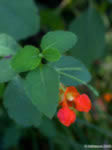Rare Wildflowers of Tennessee
by Deb Jackson
Plants and wildflowers provide a spiritual link between nature and human beings. Nothing soothes the soul quite like the sight and smell of these beautiful creations of nature. And yet they are vanishing at an astonishing rate. It is sadly estimated that at least one entire species of wildflowers goes on the extinct list in each state per year. This it seems is the path to progress, acid rain, water pollution, strip mining, deforestation, and on and on we go. Many of the plants grown by gardeners are domesticated versions of wild plants. Many other gorgeous native plants have yet to be chosen for use in horticultural cultivation. While this is not the best way to preserve Mother Nature?s scenery at least it saves a species from total annihilation.
Throughout history, plants have been of utmost importance to medicine. You may not realize it, but up to 80 percent of all medicinal drugs originates from wild plants. In fact, 25 percent of all prescriptions written each year in the United States contains certain plant chemicals. In spite of the medical advances in recent years, only about 2 percent of the entire world's plant species have been analyzed, and then only for one group of plant chemicals, called alkaloids. Any number of other plant chemicals could be useful. Take for example the Madagascar periwinkle, from which vincristine is derived. Vincristine has increased the survival rate of children with leukemia from 20 percent to 80 percent. Another extremely promising drug is taxol, derived from the Pacific Yew, which has actually worked against a broad range of cancers, including ovarian.
Food is another important example for although humans have used some 3,000 species of plants as food, 90 percent of the world's food comes from only 20 plant species. Rice, wheat, and corn, are grass species and by far the most important food plants in the world. If a new disease or pest were to suddenly wipe out even one of those species, an agricultural disaster would take place. Native plants have significant potential as sources of improved genetic traits such as disease resistance and drought tolerance. Cross breeding with wild species of sunflowers has produced the disease-resistant and productive hybrids used in the sunflower industry, which provides seeds, oil and other products. From the spearmint in toothpaste to the jojoba oil in shampoo to floral perfume, plants contribute.
So much untapped potential exists for the use of plants. Possible fuel sources like alcohols derived from corn and sugar cane and more exotic substances ranging from insect repellent to lubricants. The oxygen we breathe is produced by the photosynthesis of plants. Vegetation restricts the movement of dust and pollutants, and plants, through their intake of carbon dioxide, moderates the greenhouse effect resulting from the burning of fossil fuels. Plants are very important to the quality of water. A dense and diverse community of plants aids in maintaining healthy watersheds, streams, and lakes by stopping soil erosion, and filtering sediments from water. Forests and marshes can greatly moderate local climates. Natural disasters, such as drought, have been attributed deforestation. Plants are the basis for virtually all life on earth. The wildflowers and plants you see around you aren't only beautiful, but useful, without them life of every kind would be in danger of extinction. Plant habitats must be protected before species become critically endangered. More than 600 plant species are threatened and endangered in the U.S. and 4,500 other U.S. plant species are at risk of extinction.
The first step in appreciating wildflowers is to get a field guide and explore your own backyard. Wildflowers are easy to spot and you can also find great photos for identification on the web at altnature.com, they also a Plant Savers link to learn about and enjoy the wonders of our native wildflowers. Numerous guided walks, displays, and presentations are available from federal agencies and private organizations in order to aid you in your appreciation and understanding of the values of the wildflowers right under your nose! So PLEASE, don't pick the wildflowers.
Rare:
WOOLLY SANDWORT (Arenaria lanuginosa), RANCHED THREE-AWN GRASS (Aristida ramosissima), ROAN FALSE GOAT'S-BEARD (Astilbe crenatiloba), CAPILLARY HAIRSEDGE (Bulbostylis ciliatifolia var coarcta),
FOXTAIL SEDGE (Carex alopecoidea),
WOOLLY SEDGE (Carex lanuginosa),
MUSKINGUM SEDGE (Carex muskingumensis), STERILE SEDGE (Carex sterilis),
VELVETY SEDGE (Carex vestita),
PURSH'S RATTLEBOX (Crotalaria purshii),
ALABAMA CROTON (Croton alabamensis), CREAMFLOWER TICK-TREFOIL (Desmodium ochroleucum),
AMERICAN MANNAGRASS (Glyceria grandis),
PLAINS FROSTWEED (Helianthemum bicknellii), CANADA FROSTWEED (Helianthemum canadense), WHORLED SUNFLOWER (Helianthus verticillatus), HIGHLAND RUSH (Juncus trifidus),
PASTURE GLADE-CRESS (Leavenworthia exigua var lutea),
GRAPE HONEYSUCKLE (Lonicera prolifera),
STIFF CLUBMOSS (Lycopodium annotinum), DROOPING BLUEGRASS (Poa saltuensis),
WHORLED MOUNTAIN-MINT (Pycnanthemum verticillatum),
PRAIRIE RHYNCHOSIA (Rhynchosia latifolia),
WHITE BEAKRUSH (Rhynchospora alba),
HORNED BEAKRUSH (Rhynchospora capillacea), WRIGHT'S BEAK-RUSH (Rhynchospora wrightiana), SENNA SEYMERIA (Seymeria cassioides),
VIRGINIA MALLOW (Sida hermaphrodita),
ROYAL CATCHFLY (Silene regia),
BROADLEAF GOLDENROD (Solidago lancifolia), BRANCHING BUR-REED (Sparganium androcladum), YELLOW NODDING LADIES'-TRESSES (Spiranthes ochroleuca),
PINELAND SQUAREHEAD (Tetragonotheca helianthoides),
SAND GRAPE (Vitis rupestris)
Extinct: Chaffseed (Schwalbea americana),
Twinflower (Linnea borealis),
Lambkill (Kalmia angustifolia var carolina),
Roseroot (Sedum rosea),
GREEN PITCHER PLANT (Sarracenia oreophila)
Deb Jackson
Back to Library





